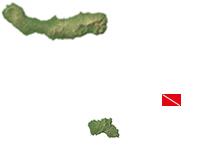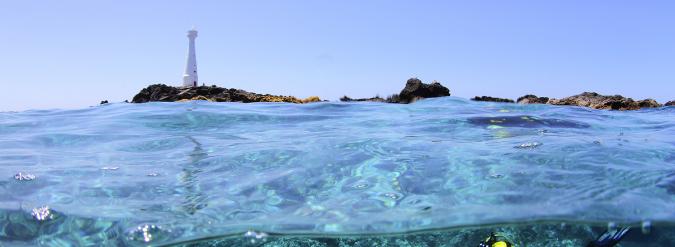Ilhéus das Formigas
Description
By boat
70 minutes from the Vila do Porto Harbour (Santa Maria), 120 min from the Vila Franca do Campo Harbour (São Miguel), 150 min from the Ponta Delgada Harbour (São Miguel).
Depth

Ilhéus das Formigas
The experience of diving on the Ilhéus das Formigas (Formigas Islets) begins when you board the boat for the 33-nautical-mile trip from the southeast tip of São Miguel, or the 20-mile trip from the island of Santa Maria. The remote location and strong currents mean that it is only recommended for experienced divers, but for those that have dive skills this is one of the best sites in the Azores. Many divers opt to combine this dive with Dollabarat Reef, another marine reserve in close proximity.
The long trip from any of the islands is in itself a great adventure, allowing divers to see cetaceans, turtles and seabirds on their journey toward the islets, marked by a small lighthouse. Even before dropping the anchor, you can see some of the schools of fish that abound in these crystal clear waters, such as Bermuda chubs (Kyphosus sectator), grey triggerfish (Balistes carolinensis) and Almaco jacks (Seriola spp.).
This location offers a wide variety of dive sites including the ‘Olympia’ shipwreck located on the southwest side of the islets (between 30 and 50 metres deep), a small reef that is only 8 metres deep, many dives along the wall of the islets and also several reefs to the north. What all of these sites have in common is the opportunity to see large migratory pelagic species, such as skipjack tunas (Katsuwonus pelamis), big-eye tunas (Thunnus obesus), wahoos (Acanthocybium solandri), large Atlantic bonitos (Sarda sarda), yellowmouth barracudas (Sphyraena viridensis), and white trevallies (Pseudocaranx dentex). It is also possible to see sharks, including the mythical smooth hammerhead (Sphyrna zygaena) and the Galapagos shark (Carcharinus galapagensis), along with devil rays and even huge giant mantas (Manta birostris).
In addition to the large schools in the blue, life abounds close to the seafloor, particularly with large species such as barred hogfish (Pseudolepidaplois scrofa), dusky groupers (Epinephelus marginatus) and island groupers (Mycteroperca fusca).


